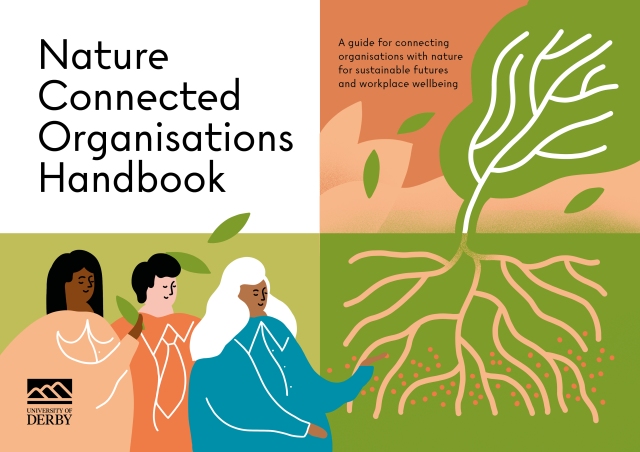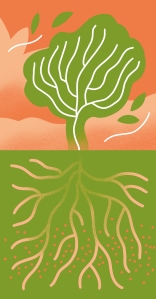A guest blog by Dr Carly Butler, Researcher in Nature Connectedness, University of Derby.
The Nature Connectedness Research Group are delighted to announce the release of a new resource for businesses and other organisations: The Nature Connected Organisations Handbook: A guide for connecting organisations with nature for sustainable futures and workplace wellbeing.
Nature connection is about how people think about, feel towards, and engage with nature. It is increasingly recognised as having a vital role to play in addressing the ecological and climate crises, as well as improving people’s psychological wellbeing. Those who have a strong sense of nature connectedness feel happier, function better, and help the environment more than those who are less connected.
Our previous Nature Connection Handbook was written to help organisations who aim to connect people with nature by providing a summary of nature connection research and evidence-based methods for helping people improve their sense of nature connectedness. We wanted to build on this to produce a second handbook to focus on internal organisational change, helping organisations grow nature connectedness amongst their own staff and management. So, we turned our attention to developing the idea of a nature-connected organisation, applying the science to develop a framework and guidance. This new handbook is the result – helping organisations of all types change how their people, infrastructures, and culture relate to nature.
The handbook offers a brief outline of the science of nature connection, explains why nature connection is important for organisations, and offers a framework and tips for bringing nature connection into an organisation. It identifies opportunities for connecting staff with nature, opportunities to develop spaces and processes that are nature connecting, and opportunities for going deeper and embedding nature connectedness into organisational culture. By closing the gaps between humans and the more-than-human world, nature-connected organisations support the mental wellbeing of their staff, make direct contributions to nature’s wellbeing, and champion transformational change to a more sustainable future for all.
Why do we need nature connected organisations?
Without global action to protect and restore nature and limit the effects of climate change, the world faces significant risks of environmental, societal, and economic breakdown and ultimately, of an unliveable planet. Organisations of all types have a key role to play in addressing these existential crises by adopting nature positive and net zero policies and practices. There is a growing wave of businesses recognising the risks and the opportunities of the climate and ecological crises and taking action to help nature and the environment. While there is a desperate need for all organisations to join this wave and for amplification and acceleration of the actions being taken, most climate and nature initiatives are missing an opportunity to address one of the root causes of the planetary emergencies – the breakdown of the human-nature relationship.
Over generations, people have become disconnected from the more-than-human world, becoming increasingly anthropocentric and nurturing a relationship with nature based on dominance and exploitation. Daily life often offers little opportunity for the kind of close engagement, appreciation and care for nature that can foster a closer relationship with nature. For individuals, having a close relationship with nature is essential for health and wellbeing, and on a broader level, a society that is connected with nature cares for it – protecting, regenerating and nurturing the environment. Changing how people think about, feel towards, and engage with nature is essential for addressing the loss of biodiversity and climate change that threatens our world.
Becoming a nature connected organisation can help businesses go beyond risk limitation, mitigation measures, the setting of targets, and surface-level changes to tick the boxes for climate and nature action, to effect meaningful change for staff, the organisation, nature, and society at large. Too often humans are absent from net zero and nature positive strategies, yet work to address people’s relationship with nature is fundamental to the kind of societal transformation that the crises requires. Organisations have an untapped potential to lead on this work, by becoming more nature connected and connecting.
Nature connected organisations are also essential for the wellbeing of staff. When people feel emotionally connected with nature they are happier and more satisfied with life. Organisations can help staff develop their sense of nature connectedness by embedding nature connection practices and principles into their day-to-day activities. Organisational spaces and infrastructure can be designed to help facilitate the development of closer emotional bonds with nature, while cultural shifts within an organisation can ensure a focus on nurturing nature and put a relationship with nature at the heart of its operations and visions. A focus on nature connection can also boost the financial and operational success of an organisation, with healthier and happier staff leading to greater productivity, reduced sick leave, and increased creativity and innovation.
The handbook offers practical guidance for organisations to bring nature connection into their workplace and culture. It sets out a pathway for uniting well-being and sustainability agendas and enacting corporate responsibility for delivering integrated social and environmental benefits for staff, society, nature – and the organisation itself. We have developed a ‘tree framework’ that organisations can use to audit their current practices and policies and to identify, design, and develop actions they can take towards becoming nature connected. The framework invites reflection and action across all levels of an organisational tree: the staff (the crown), the structures (the trunk), the culture (roots) and the community (soil).
It is designed to be useful to organisations across sectors – from small, medium to large businesses, charities and NGOs, public sector organisations, and community groups – and for people at all levels of an organisation, whether CEOs, trustees or directors, sustainability leaders, human resource managers, wellbeing champions, or employees wanting to initiate steps towards nature connection in their organisation. There are lots of ideas for actions – big and small – that organisations could do to boost nature connectedness. These range from use of five nature connection practices that organisations could use as part of a staff nature connection or wellbeing initiative, or ideas for ‘nature-hacking’ workspaces, through to suggestions for embedding nature connection principles in organisational culture by having nature connection as a KPI or putting ‘nature on the board’. Examples from SMEs, NGOs and public service organisations that already nurture nature connection are shared.
The handbook is free and available to download at bit.ly/ncohandbook. As with the original handbook, we are grateful to Minute Works and Catherine Chialton for the beautiful design and illustrations.



